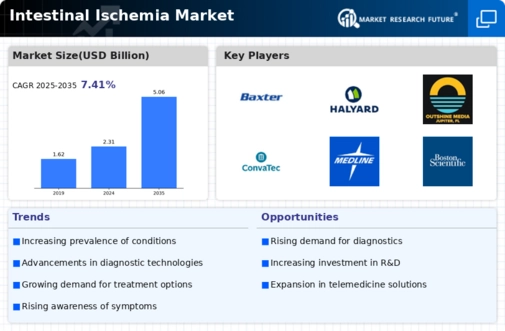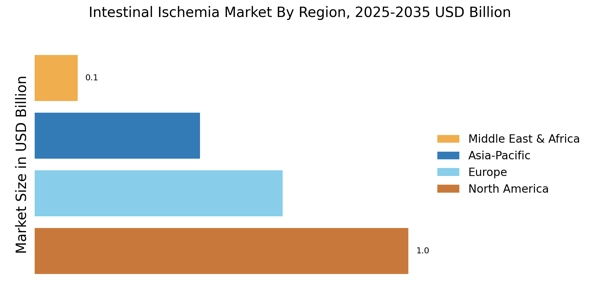Emerging Therapeutic Options
The emergence of novel therapeutic options is reshaping the landscape of the Intestinal Ischemia Market. Recent advancements in pharmacological treatments, including new anticoagulants and vasodilators, are providing healthcare providers with more tools to manage intestinal ischemia effectively. These innovative therapies are designed to improve blood flow and reduce the risk of ischemic events. As research continues to unveil new treatment modalities, the market is likely to witness an influx of products aimed at addressing the complexities of intestinal ischemia. This evolution in therapeutic options is expected to enhance patient outcomes and drive market growth.
Growing Awareness and Education
There is a marked increase in awareness and education regarding intestinal ischemia, which is positively impacting the Intestinal Ischemia Market. Healthcare professionals are becoming more knowledgeable about the condition, leading to earlier diagnosis and treatment. Public health campaigns aimed at educating patients about the symptoms and risks associated with intestinal ischemia are also on the rise. This heightened awareness is likely to result in increased patient consultations and a subsequent demand for diagnostic and therapeutic options. As awareness continues to grow, the market is expected to expand, driven by informed patients seeking effective solutions.
Increase in Geriatric Population
The aging population is a critical factor driving the Intestinal Ischemia Market. As individuals age, they are more susceptible to various health issues, including vascular diseases that can lead to intestinal ischemia. Projections indicate that the geriatric demographic will continue to grow, resulting in a higher incidence of related health conditions. This trend necessitates the development of specialized treatment options and healthcare services tailored to the needs of older adults. Consequently, the market is poised for growth as healthcare systems adapt to accommodate the increasing demand for care related to intestinal ischemia among the elderly.
Advancements in Surgical Techniques
Innovations in surgical techniques are significantly influencing the Intestinal Ischemia Market. Minimally invasive procedures, such as laparoscopic surgeries, have gained traction, offering patients reduced recovery times and lower complication rates. The introduction of robotic-assisted surgeries further enhances precision and outcomes. As these advanced techniques become more widely adopted, they are expected to drive demand for related medical devices and technologies. The market is likely to experience growth as healthcare facilities invest in state-of-the-art surgical equipment to improve patient care and outcomes in intestinal ischemia cases.
Rising Incidence of Vascular Diseases
The increasing prevalence of vascular diseases is a notable driver for the Intestinal Ischemia Market. Conditions such as atherosclerosis and peripheral artery disease contribute to a higher risk of intestinal ischemia. According to recent data, vascular diseases affect millions, leading to a growing demand for effective diagnostic and therapeutic solutions. This trend is likely to propel the market forward as healthcare providers seek to address the rising number of patients suffering from these conditions. The need for innovative treatments and advanced diagnostic tools is becoming more pronounced, suggesting a robust growth trajectory for the Intestinal Ischemia Market in the coming years.


















Leave a Comment